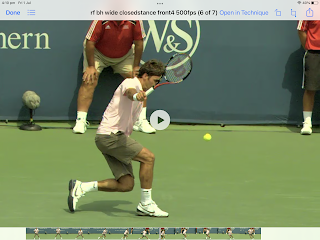There you go Matt, these were your Forehands as first recorded on the 5th of June. You may have improved it already but nevertheless let’s break it up in parts to understand it better.
I’ve highlighted two major ares to improve your Forehand:
Stance
Trigger Position
001
The first thing I notice when looking at your shots, specially the ones recorded from the side angle is how far back you are on the court. You’re not too far away from hitting the back fence with your racquet. Because of that you are not optimising your open stance.
The stance is how we position our feet at the end of our backswing. After we commit to our stance we are loaded and ready to start our forward swing towards contact to the ball.
We basically have 4 good different stances that we use on our forehands:
Neutral Stance, when we step in to the ball with the inside foot (left foot for right handlers)
Semi Open Stance, when we position our feet with the outside foot closer to the side fence and the back fence. It’s a mixture of a step back and a step out with the outside foot. This stance is probably the favourite of the pros because allows more time for contact, and maximum rotation.
Open Stance, when we position our feet at the same distance to the net. Although we have less rotational power than a semi open stance it is easier to make contact more in front of the body. Players may have to use the open stance because the incoming ball might be short but not giving enough time to step in to it or step back to a semi open stance. It’s typical stance for return of serves.
Extreme open stance, when we position the outside foot forwards stepping in to the ball. This is not a desirable stance since by opening up our hips we lack rotation and power, but we might have to play it when retrieving low, short and angled shots into our forehands.
So now let’s see why your Open Stance doesn’t really suit the shots yore hitting.
002
003
Instead of stepping in you have waited passively on that open stance and then because the ball is dying in front of you, you were forced to move your body forward towards the contact. Notice the low contact point.
004
From the back view, we can be aware of the other major element of your forehand that needs some improving!
I call it the trigger position!! It’s basically when we prepare the wrist for contact. It typically happens a few moments before contact. The wrist should be laid back for impact. When it happens the racquet head tends to go into the inside just before contact. We normally say to line up the butt of the racquet in the direction of the ball. Here’s Fed’s trigger position on the forehand:
Whiteout this trigger position the wrist is not ready for impact. What happens between the Trigger position and the contact point is one of the most crucial and fundamental elements to master the Forehand.
As the wrist is laid back and ready, the hand leads the racquet into the direction of impact. In those very fast moments before the impact, if the racquet head moves faster than the right hand, then the wrist’s back position is compromised and the player won’t be able to have a solid contact and extension into the line of the shot. Very often a poor extension after contact and a poor follow through are signs of a weak wrist at contact.
Notice on the following pictures, how after the trigger position is achieved on the first pic, the right hand is still in front of the racquet head up until contact happens. We want the right hand and the racquet head levelled or with the hand slightly in front of contact, but not with contact in front of the right hand! (Maybe except for extreme wristy shots like angle passing shots or shots on the run?…)
Notice how on the last picture at contact, Fed still has his right hand in front of his contact point:
So the wrist is kept laid back in a strong position where it’s able to absorb the impact of the ball on the strings and it’s kept back for a few more moments after impact to ensure the shot has maximum extension. Then after the follow through the wrist relaxes and therefore the racquet finishes up and on the outside and left of the right hand.
Looking at your wrist at contact we can see how it’s not entirely laid back. It’s not as strong as it should be. It even seems that the contact point is in front of your right hand:
005
006




































